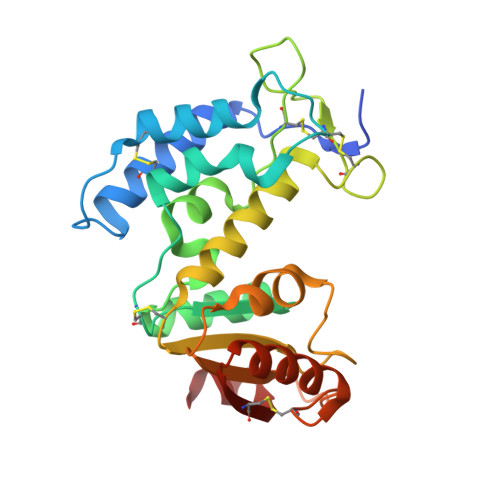Insights into the mechanism of bovine CD38/NAD+glycohydrolase from the X-ray structures of its Michaelis complex and covalently-trapped intermediates.
Egea, P.F., Muller-Steffner, H., Kuhn, I., Cakir-Kiefer, C., Oppenheimer, N.J., Stroud, R.M., Kellenberger, E., Schuber, F.(2012) PLoS One 7: e34918-e34918
- PubMed: 22529956
- DOI: https://doi.org/10.1371/journal.pone.0034918
- Primary Citation of Related Structures:
3GC6, 3GH3, 3GHH, 3KOU, 3P5S - PubMed Abstract:
Bovine CD38/NAD(+)glycohydrolase (bCD38) catalyses the hydrolysis of NAD(+) into nicotinamide and ADP-ribose and the formation of cyclic ADP-ribose (cADPR). We solved the crystal structures of the mono N-glycosylated forms of the ecto-domain of bCD38 or the catalytic residue mutant Glu218Gln in their apo state or bound to aFNAD or rFNAD, two 2'-fluorinated analogs of NAD(+). Both compounds behave as mechanism-based inhibitors, allowing the trapping of a reaction intermediate covalently linked to Glu218. Compared to the non-covalent (Michaelis) complex, the ligands adopt a more folded conformation in the covalent complexes. Altogether these crystallographic snapshots along the reaction pathway reveal the drastic conformational rearrangements undergone by the ligand during catalysis with the repositioning of its adenine ring from a solvent-exposed position stacked against Trp168 to a more buried position stacked against Trp181. This adenine flipping between conserved tryptophans is a prerequisite for the proper positioning of the N1 of the adenine ring to perform the nucleophilic attack on the C1' of the ribofuranoside ring ultimately yielding cADPR. In all structures, however, the adenine ring adopts the most thermodynamically favorable anti conformation, explaining why cyclization, which requires a syn conformation, remains a rare alternate event in the reactions catalyzed by bCD38 (cADPR represents only 1% of the reaction products). In the Michaelis complex, the substrate is bound in a constrained conformation; the enzyme uses this ground-state destabilization, in addition to a hydrophobic environment and desolvation of the nicotinamide-ribosyl bond, to destabilize the scissile bond leading to the formation of a ribooxocarbenium ion intermediate. The Glu218 side chain stabilizes this reaction intermediate and plays another important role during catalysis by polarizing the 2'-OH of the substrate NAD(+). Based on our structural analysis and data on active site mutants, we propose a detailed analysis of the catalytic mechanism.
Organizational Affiliation:
Department of Biological Chemistry, University of California Los Angeles, Los Angeles, California, United States of America. pegea@mednet.ucla.edu


















